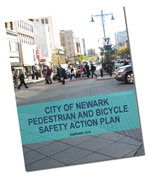Bicycle/Pedestrian

The NJTPA is committed to promoting walking and biking in its region. Its goal is to make these two travel modes convenient, safe, efficient, and attractive as viable alternatives to cars for shorter trips.
Much of this commitment is made through direct investment in bicycle and pedestrian facilities including bicycle and pedestrian trails, pedestrian overpasses, and waterfront walkways. In addition, various transportation projects, such as bridge replacements and intersection improvements, incorporate features to make walking and biking safer and more attractive travel options in the region. The NJTPA also conducts planning to support walking and biking including the following:
- The NJTPA completed its Regional Active Transportation Plan in 2023 to help establish a safe and functional regional network of pedestrian and bicycle facilities. This consultant-supported study aims to advance the regional goal of increasing non-motorized travel options by strategically addressing critical gaps in the regional active transportation network. The development of the plan included outreach and data-driven methods, and advancing strategies from the Long Range Transportation Plan to prioritize equitable access to the regional network.
- The NJTPA analyzed the road network for the purpose of creating a Level of Bicycle Compatibility (LBC) index for the region. This initiative supports the goal of safe and efficient access for all modes of travel. The analysis provides the groundwork for assessing bicycle network connectivity for the region, including off-road bike paths. This analysis included reviews of similar analyses by other agencies from which NJTPA created a four-level categorization of bicycle compatibility (sometimes referred to as bicycle comfort or level of traffic stress) for each road and path in the region. NJTPA has a description of the criteria as well a map with the latest LBC measures.
- The NJTPA leads a wide ranging pedestrian safety education and enforcement campaign which began in four pilot communities in 2013, and has expanded statewide to over 200 communities, with additional campaigns conducted each month. Campaign materials for use by other communities are available on the Street Smart NJ resources page. To learn more visit our Street Smart NJ website, www.bestreetsmartnj.org.

-
The NJTPA sponsors Walkable Community Workshops to identify measures that will help towns support increased walking trips within the NJTPA region. These workshops are offered as part of our competitive Complete Streets Technical Assistance Program. Work includes examining assets and safety deficiencies and providing examples of solutions for missing sidewalk links, traffic signals, crosswalks, signage, and traffic calming measures.

- The NJTPA supports and encourages the adoption Complete Streets to provide safe access for all roadway users, of all ages and abilities, including bicyclists, pedestrians, and transit riders. "Completing the Streets" incorporates design and operational features that create a comprehensive, integrated, and connected multi-modal network of transportation options. The NJTPA also supports and coordinates with NJDOT’s statewide Complete Streets Policy and the Routes to School program. Several counties and municipalities within the NJTPA region have a Complete Streets Policy or are developing one.
-
The NJTPA has supported the completion of New Jersey’s portion of the East Coast Greenway. This is a 2,600-mile planned route that combines connected on-road and off-road facilities from Maine to Florida.
-
The NJTPA has supported planning studies of the historic Morris Canal, including in Warren County, Jersey City in Hudson County and in Passaic County. The Morris Canal Working Group (MCWG) builds upon those efforts. The working group brings together stakeholders and other interested parties to discuss this important resource and to help coordinate current and future plans for the corridor. Membership in the Morris Canal Working Group is open to all interested parties. Additional information on the Working Group is available at www.morriscanalgreenway.org.